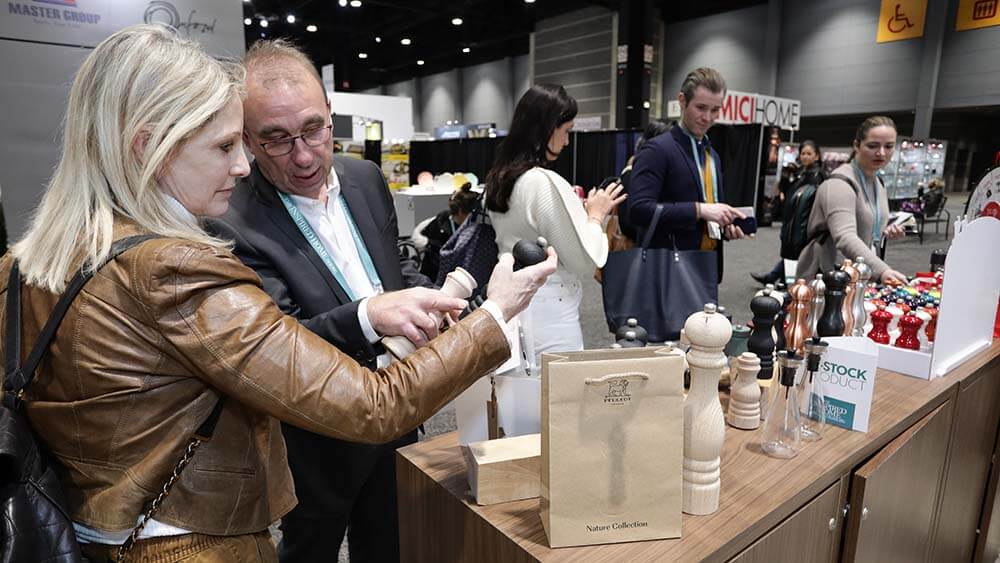
Participants at the Inspired Home Show, March 5-8 at Chicago’s McCormick Place, peruse the “In Stock” products area, which helped attending retailers overcome supply-chain issues. (Courtesy of International Housewares Association)

Kimberly Hardcastle-Geddes
I’ve had my ear to the ground during the nearly first quarter of the year and have aggregated the following advice and insights from organizers who have planned, produced, supported and/or marketed successful 2022 events.
1. Don’t let perfect be the enemy of good. Understand that your event might not be the logistically flawless masterpiece that you want it to be due to elements outside of your control — like last-minute cancellations, travel and shipping delays, and labor shortages. The show must go on, so commit to doing the best you can with what you have and giving yourself extra grace.
2. Filter out the noise. You’ll likely have loud critics weighing in on all your decisions — from exercising (or abandoning) COVID-19 safety regulations to holding an event in (or moving an event from) a state that’s instituted controversial legislation, to the way you are assigning priority to exhibitors who pulled out of your last show. Stay true to your brand values and listen to the stakeholders who truly matter. And on that note …
3. Define who your event is for. If a handful of your bellwether exhibitors pull out or a few high-profile organizations say they can’t attend due to travel restrictions, ask yourself: Who is my show for, anyway? Is it only for a handful of the major brands in our space? Or do we have an obligation to stage an event that helps small- and medium-sized businesses, as well? Many organizers who had previously assumed that their show would lose its essence without the big brands present have been very happy to be wrong.
4. Redefine your event’s compelling value proposition. The Inspired Home Show created an “In Stock” program to help retailers identify suppliers who had products in stock and ready to be shipped. A new benefit of attendance is the ability to overcome supply-chain problems. And speaking of redefining things …
5. Consider redefining everything about your current event. Before we thought of our competitors as other shows that competed with ours. Now, we must broaden that definition to include a host of online options, including broad offerings like LinkedIn Learning. We know that attendees want to be actively engaged in the experience, so why not call them participants, instead? And don’t even get me started on the concept of a hybrid event. Most organizers have have realized that staging a live and virtual event simultaneously adds unnecessary layers of cost and complexity (not to mention staff burnout). Consider an omnichannel content strategy instead. Most importantly, redefine your measurements of success to be less about the numbers we, as organizers, like to talk about and more about the value we deliver to our participants.
6. Think outside the box (or booth). Have an international exhibitor who has had to cancel? Or one that’s questioning participation because supply-chain challenges are impacting their ability to fulfill orders? Find new ways to give them exposure — by turning their booth into a branded lounge or providing an alternate digital solution or sponsorship opportunity. In general, find creative, innovative ways to help your exhibitors stay connected to your event while overcoming the new set of challenges they might be facing in the current reality.
7. Increase your exposure through added PR efforts. In many markets, local media outlets are excited to report on the return of major events in their regions and the impact they are making on travel, tourism, restaurants, etc. Proactively reach out and pitch a compelling story. Work with the Exhibition and Conferences Alliance to gather stats that demonstrate the importance of events to a local market.
8. Take control of your own narrative. When there is uncertainty about whether a show will proceed and who is or isn’t exhibiting, the rumor mill kicks into gear. Tell your own story by channeling certainty into a strong message that includes what you do know about who is attending, speaking, and exhibiting and why the event is important to the industry. In addition to telling the story on your own channels, work with trusted media partners to broaden your reach.
9. Don’t underestimate the power of FOMO. Over the past several months, I’ve heard a number of exhibitors say they regret the decision not to attend an event. Their absence is giving their competitors access to buyers who are actively sourcing new suppliers — and many of these buyers have quite a bit of extra time to do so since they aren’t in meetings with their current suppliers! Ensure prospective exhibitors are aware of the message their absence will send to the industry.
10. Give more than lip service to “we’re not going back to 2019.” Many organizers are saying this while simultaneously reverting to the exact same playbook — the same floorplan, marketing tactics, event content, and formats. We go back to the past because we know it. The future is uncertain and scary — we must get comfortable being uncomfortable and taking risks to try new things.
Kimberly Hardcastle-Geddes is president and chief marketing strategist of mdg, a marketing and public relations agency specializing in audience acquisition for live and online events.
